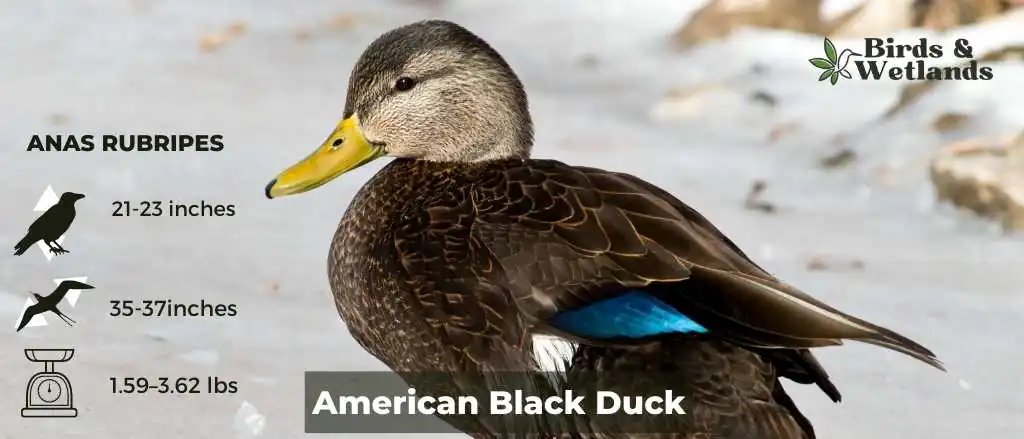The American black duck (Anas rubripes) is a large dabbling duck native to North America that stands out in the duck family for its distinctive size and coloration. The male and female of this species share similar features, with the male’s bill being yellow and the female’s being dull green with dark marks.
Although initially quite a common bird, their population numbers drastically declined due to hunting in the mid-twentieth century. However, through hunting restrictions and protection from conservation efforts, their population has stabilized over time.
As an intelligent bird known to hide in plain sight within shallow wetlands, it is often found among flocks of mallards, where it can easily blend in with female Mallards.
Scientific Name: Anas rubripes
Height: 54–59 cm (21–23 in)
Wingspan: 88–95 cm (35–37 in)
Weight: 720–1,640 g (1.59–3.62 lb)
Description
American ducks are similar to female mallards in size and coloration, but the black duck’s plumage is darker. They are closely related to the mallards.
The most noticeable characteristic of this bird is the iridescent violet-blue speculum, which lacks white borders with predominantly black margins on its wings.
Males
The adult male American black duck has a distinguished physical appearance. Its body is dark brown, while its head is pale brown.
The male black duck also has reddish-orange legs that stand out against its other features. White wing linings are visible while these birds are in flight, giving them a more striking look.
Its bright yellow bill contrasts its other features, while its tail feathers are grey with black streaks running throughout them, adding to the complexity of the bird’s appearance.
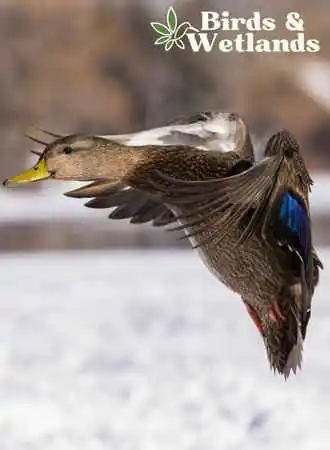
Females
The adult female American black duck has a dark brown body and pale brown head. Its bill is dull green or olive in color and appears to be slightly upturned.
The female of this species has a lighter overall plumage than the male, with the wings being particularly light in coloration. Its underside can vary from white to off-white, and its back feathers have speckled tips which are generally paler than the main section of each feather.
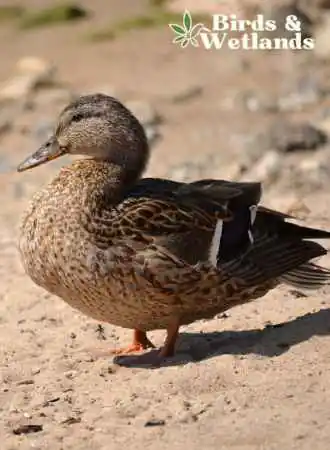
Listen to American Black Duck
Habitat & Range
The American black duck breeds in coastal wetlands throughout the eastern United States. In Canada, these birds breed in Nova Scotia, northern Saskatchewan and the Maritime Provinces.
Their breeding habitats include shallow lakes, salt marshes, and forested wetlands in northeastern North America and along the Atlantic coast during the spring and summer months.
These ducks also migrate to southern breeding grounds such as small coastal ponds, acid bogs, brackish estuaries, alkaline marshes and large rivers. Preferred nesting sites typically have dense cover from predators and thick emergent vegetation such as cattails and rushes.
These ducks forage for food in aquatic vegetation such as eelgrass beds or nearby fields during the summer months. During this time, American black ducks can be seen preening and resting on shorelines or among waterfowl flocks.
In the winter, these ducks use the Atlantic and Mississippi flyways to travel south. They are often seen with other duck species resting and feeding in various stopover locations such as in tidal marshes and coastal areas. Most black ducks winter between Long Island and North Carolina.
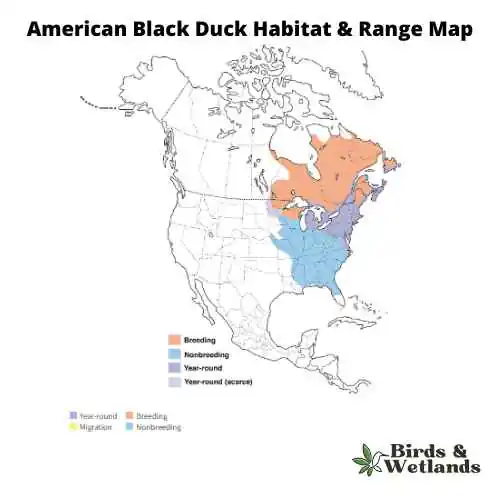
Diet & Food Habits
Like other dabbling ducks, the American black duck feeds by dabbling on the water’s surface. It eats mostly aquatic plants and insects during the breeding season. In shallow water, they forage by submerging their heads and tipping up to feed on aquatic vegetation, tubers, roots, and other food sources in deeper waters.
In the winter and fall migration, when most plant sources are scarce, the diet of this bird species shifts to include more animal matter, such as small fish, snails, insect larvae, mayflies, dragonflies, beetle and other small invertebrates.
American black ducks have also been observed eating land insects such as grasshoppers, flies, and spiders. They also spend time in agricultural fields looking for seeds and fallen grain.
During the summer, they consume many black fly larvae found in streams and rivers where they breed.
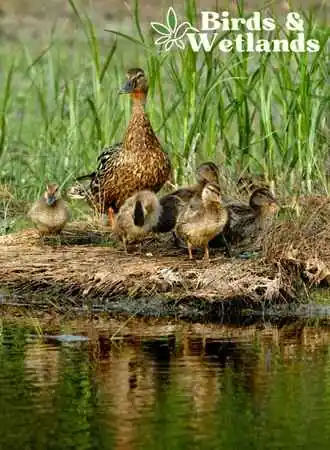
Nesting & Mating Habits
Mating rituals of the American black duck usually start in early spring, when most pairs form.
During courtship, males actively pursue females, often chasing them around a pond or marsh in an attempt to win their favor. The female may also try to draw attention to herself by fanning her tail feathers and raising her crest while loudly quacking.
After forming a pair, they mate in shallow waters such as small lakes or ponds at night.
Females choose well-hidden nesting sites in areas such as wooded islands, uplands, marshes, cultivated croplands, and cropland borders between April and June.
The female will then add plant material collected nearby to the nest as insulation before laying 6-14 cream-colored eggs, which she will incubate for 25-30 days.
The female leads the young ducks or ducklings to the water when the eggs hatch.
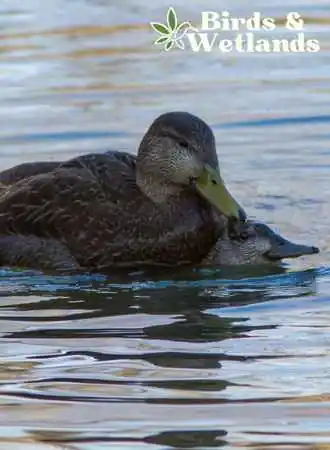
Population & Conservation Status
Although the American black duck is a common waterfowl, its population has declined recently. Despite the worrying population trend, the IUCN assigned the species the conservation status of Least Concern.
The global breeding population of this species is currently around 700,000 individuals. This is a decrease from the estimated 1.6 million individuals counted in 2002, and it may indicate a concerning trend of black duck declines.
Current threats to these ducks include habitat loss, wetland conversion, pollution, hunting pressure, climate change and predation.
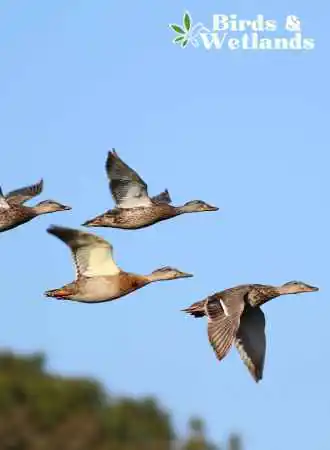
Hunting
The American black duck is allowed to be hunted in many parts of the United States, subject to certain regulations. Generally speaking, the waterfowl hunting season for the black duck runs from late September to late January in most states.
During this time, hunters can only take a certain number of birds daily and must use non-toxic shots when hunting.
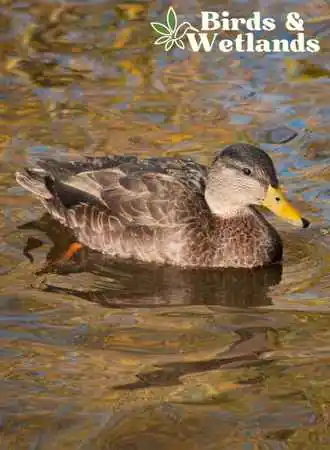
Key Points
- The American black duck is a dusky duck that resembles the female mallard, their close relative.
- The incubation period is between 25 to 30 days.
- American black ducks are omnivores, eating both plant and animal matter.

